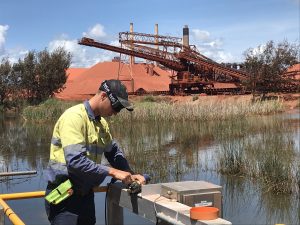VE partners with clients for the long term
3 April, 2020
 In the age of cloud computing, 24/7 connectivity and the Internet of Things, data is undoubtedly one of a business’s greatest intangible assets.
In the age of cloud computing, 24/7 connectivity and the Internet of Things, data is undoubtedly one of a business’s greatest intangible assets.
It follows that data integrity is essential. Vision Environment has been collecting high quality, real-time environmental data for more than a decade and many of its clients have been on board for the long term.
“Five, six, seven year or even longer partnerships with our clients are not unusual,” says Leonie Andersen, director at VE.
“Environmental monitoring has evolved to the point where companies aren’t just looking at it as a compliance check box,” she says.
“People see themselves as custodians of the waterways and ocean areas in which they operate and they want to be proactive about protecting them.
“One of the best ways to do this is to build a bank of high quality data over time. This enables you to establish benchmarks and norms, immediately flag any changes, and confidently assess the causes of these changes.
“Our clients trust us to deliver quality data and scientific rigour, time and again.
“Of course, from a regulatory point of view, a solid baseline of environmental data is always an encouraging thing to provide in a permit application, too.”
Vision Environment offers services including telemetry, water quality and sediment monitoring and ecological monitoring and assessment.
This month, we are profiling a few of our longer-term clients and the great work we continue to do together.
Queensland Alumina (QAL): 2015 to 2023
VE undertakes the calibration, maintenance and management of data of water quality instruments at six real-time monitoring stations on-site at QAL.
We replace and/or clean measuring sensors and then check the readings against our own sensors to ensure they are both reading the same.
The major parameters we monitor at QAL include:
- Flow rates
- pH
- Dissolved oxygen.
Each monitoring station is telemetered and sends the recorded sensor data both to our VECloud server and to QAL for real-time data viewing.
We also undertake regular water quality sampling in the marine receiving environment around QAL, with both real-time data stations and manual sampling.
Port Curtis Integrated Monitoring Program (PCIMP): 2006 to 2022
PCIMP is a collaboration between industry, government and research bodies. It conducts ambient mid to far field monitoring of water bodies for the whole of Port Curtis.
VE undertakes quarterly water and sediment sampling and analysis for PCIMP at 54 sites. Monitoring takes place using handheld WQ meters, discrete water sampling and, until recently, biomonitor organisms (transplanted oysters).
Quality assurance and control components are extensive, including duplicates, triplicates, and analysis at primary and secondary laboratories.
VE is additionally responsible for data collation and annual report writing.
The data we collect is also provided to the Gladstone Health Harbour Partnership for its annual report card, making this ongoing monitoring an excellent example of the environmental value that can be created when multiple parties commit to investing in a long-term data source.
Gladstone Ports Corporation (GPC): 2008 to 2021
VE has a long history of working with Gladstone Ports, currently as part of the Clinton Vessel Interaction Project (CVIP), for which dredging kicked off in February 2020.
Among other work with GPC, VE looked after water quality monitoring for the three-year Western Basin Dredge project in 2010 and the Chanel Duplication EIS 2015. It has also run monitoring for the port’s last seven maintenance dredging programs. All of these projects rely on real-time data for dredge management backed up by manual sampling.
Our detailed understanding of the area’s natural expected background conditions is supported by the years of high quality data that we have collected and analysed.
We also know the port area inside out and we are used to dealing with typical Queensland coast challenges such as bouts of wilder weather. We know what to expect and how to safely ensure minimum disruption to our monitoring services.
Lyttleton Port of Christchurch (LPC): 2016 to 2020
Lyttleton’s channel deepening, widening and lengthening project is New Zealand’s largest dredge project and the longest dredge project VE has undertaken monitoring for.
VE was involved from the start, coming on board in 2016 to help LPC design a monitoring program that incorporated world’s best practice.
At the peak, we had permanent field officers based in Christchurch and other support staff from our scientist and analyst team flying over as needed.
We still have buoys in the water, conducting real-time monitoring today, although requirements have evolved as the initial phases of the project near completion.
Jared Pettersson, project director at LPC, notes the quality and reliability of the data has been excellent for the entire period we’ve been in the water.
LPC now has a comprehensive bank of high quality data that captures their water quality and sedimentation characteristics over four years.
Not only does this provide LPC with an invaluable business resource to assess potential impacts of any future projects, it has also helped to build a strong trust connection between LPC and the community. LPC uses our real-time data dashboard to feed their excellent Harbourwatch website, which facilitates greater environmental transparency in an area that is used for recreation, research and industry.
